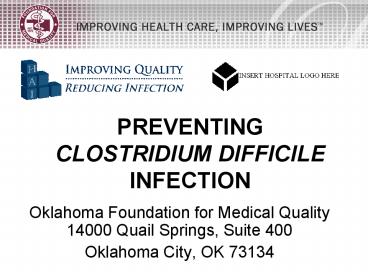PREVENTING CLOSTRIDIUM DIFFICILE INFECTION - PowerPoint PPT Presentation
1 / 20
Title:
PREVENTING CLOSTRIDIUM DIFFICILE INFECTION
Description:
PREVENTING CLOSTRIDIUM DIFFICILE INFECTION Oklahoma Foundation for Medical Quality 14000 Quail Springs, Suite 400 Oklahoma City, OK 73134 Clostridium difficile ... – PowerPoint PPT presentation
Number of Views:52
Avg rating:3.0/5.0
Title: PREVENTING CLOSTRIDIUM DIFFICILE INFECTION
1
PREVENTING CLOSTRIDIUM DIFFICILE INFECTION
- Oklahoma Foundation for Medical Quality 14000
Quail Springs, Suite 400 - Oklahoma City, OK 73134
2
Clostridium difficile
- Anaerobic, gram-positive, spore-forming,
toxin-producing bacillus - Spores germinate into vegetative bacteria in the
small intestine - Spores survive in the environment 5-6 months
- Alcohol gel does not kill spores
- Spores are removed from our hands with soap and
water
3
Clostridium difficile associated Diarrhea (CDAD)
- 10-20 of cases of antibiotic-associated
diarrhea - Around 85 of cases of antibiotic associated
colitis - gt300,000 cases/year
- 90 of patients with CDAD have skin contamination
- 60 of patients have skin contamination after
clinical resolution
4
(No Transcript)
5
Costs
- CDI is associated with an increased length of
stay by 2.6 to 4.5 days - 2,500 to 3,500 per episode
- Cost management of this infection exceeds 3.2
billon annually - Mortality rate of 6.9 at 30 days and 16.7 at
one year - APIC Guide to the Elimination of Clostridium
difficile in Healthcare Settings, 2008.
6
The Clostridium difficile Cycle
7
C. difficile Bundle
- Early detection
- Contact isolation
- Strict Glove Use
- Hand Hygiene with Soap and Water
- Minimize number of patients per room
- Intensified housekeeping measures
- Dedicated equipment
- Antibiotic Stewardship
Loo VG, et al. Can Med Assoc J. 200417147-48.
8
CONTACT ISOLATION
- Early Presumption Isolation
- If liquid diarrhea place patient in Contact
Isolation - Isolate in Private Rooms
- When can I request a patient be removed from
Isolation? - When diarrhea is gone for 24 hours
- If patient placed in presumptive isolation,
remove when 3 stool samples are negative,
collected 1 day apart and WBC and temp are normal - Send Stool samples to the lab within 2 hours of
collection or refrigerate.
9
C. difficile Infection
- Within hospitals and chronic-care facilities,
cross-infection of C. difficile has been related
to transient carriage on hands of healthcare
workers and contamination of diverse
environmental surfaces.
10
FACTORS OF DISEASE ACQUISTION
- Fecal-Oral Transmission - means ingestion of
spores - Antibiotic/Disruption of colonic normal flora
- Hospital length of stay
- 13 colonization after 1 week of stay
- 50 colonization after 4 weeks of stay
- C. difficile can survive on environmental
surfaces 5 to 6 months
11
(No Transcript)
12
(No Transcript)
13
Strict Glove Use
14
Hand Hygiene
- Alcohol gel is ineffective against Clostridium
difficile spores - Use Soap and Water with friction to remove
Clostridium difficile spores from your hands
15
Bacteria Commonly Found in the Environment
40
20
Bed Rail
Supply Cabinet
Bedside Table
Adopted from Speck SHEA Abstract 167,
Baltimore, April 2007
16
How long can a organism live if we do not clean
with a disinfectant?
- C. difficile gt 5 months 1
- Staph aureus 5 months
- VRE 4 months
- Acinetobacter 5 months
- Viruses 2-8 hours 2
17
Dedicated Equipment
- Dedicated equipment if possible
- B/P cuff, Stethoscope, Thermometer
- Use disposable Thermometers if possible- the
handles become contaminated - Disinfect all equipment between patients
18
Outbreaks and Transmission
- Hypochlorite-based disinfectants have been used
with some success for environmental surface
disinfection in those patient-care areas where
surveillance and epidemiology indicate ongoing
transmission of C. difficile - Consult Product Information and CDC Disinfection
Guidelines
19
Antibiotic Stewardship
20
Questions
This material was prepared by Oklahoma Foundation
for Medical Quality, the Medicare Quality
Improvement Organization for Oklahoma,under
contract with the Centers for Medicare Medicaid
Services (CMS), an agency of the U.S. Department
of Health and Human Services. The contents
presented do not necessarily reflect CMS policy.
HAI-1110-OK-0810































